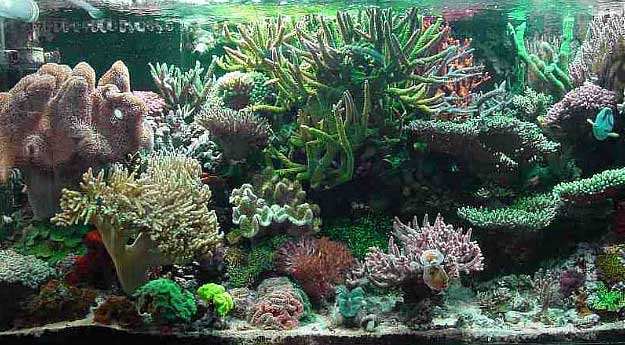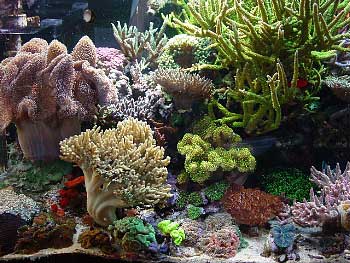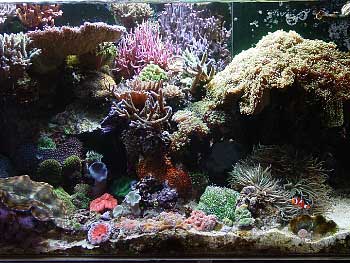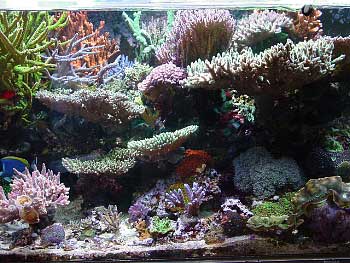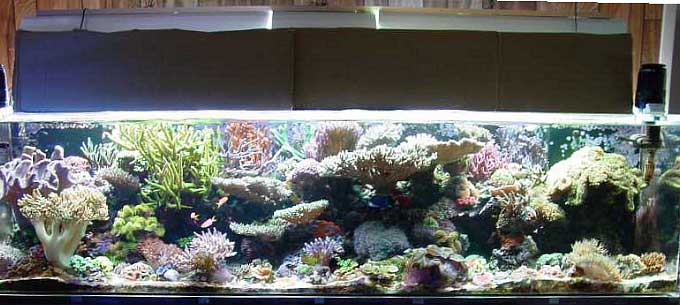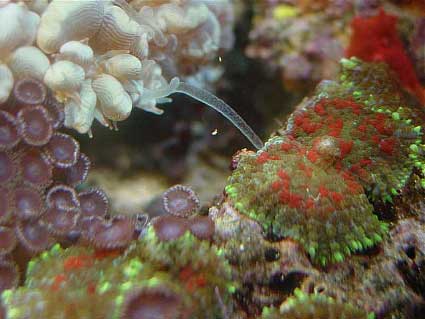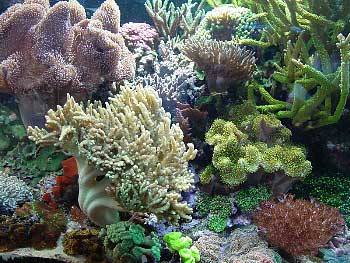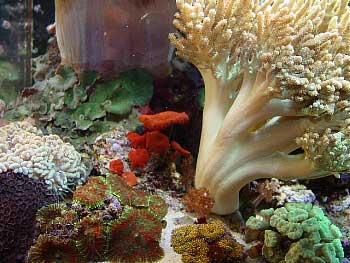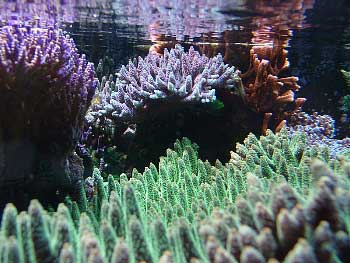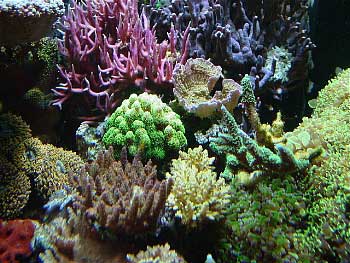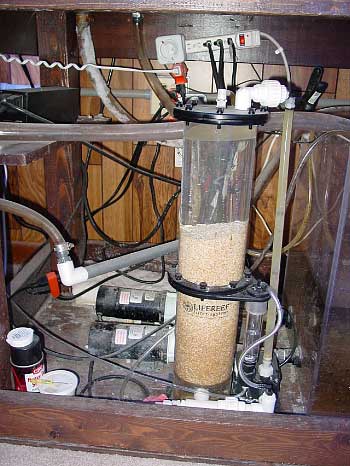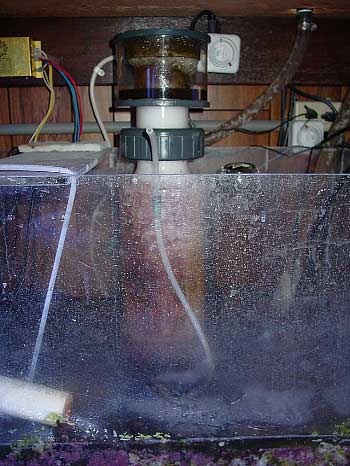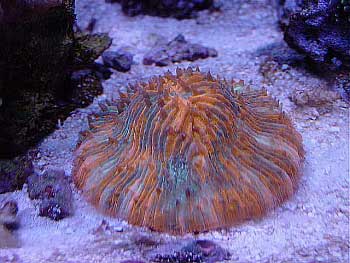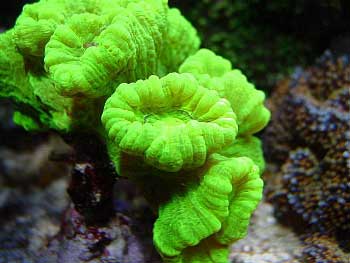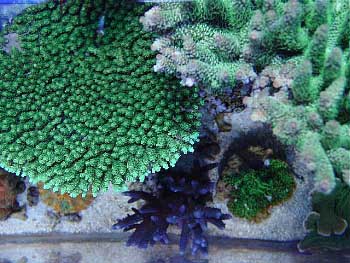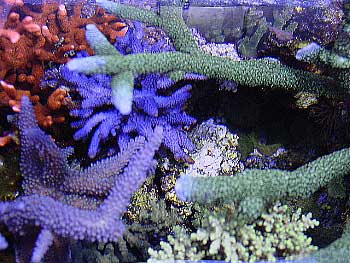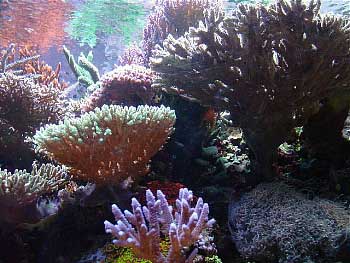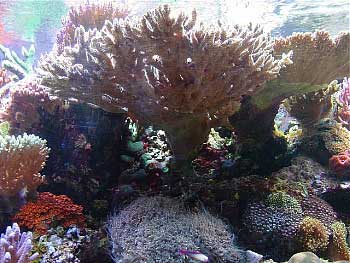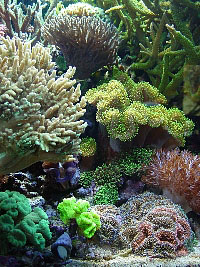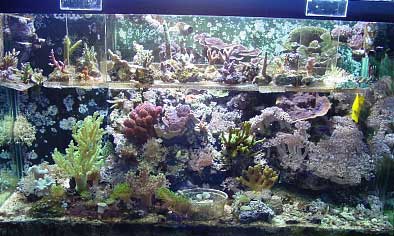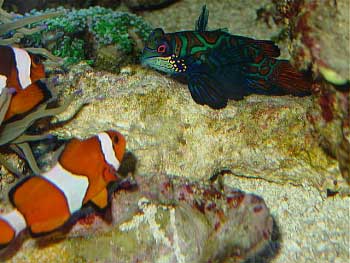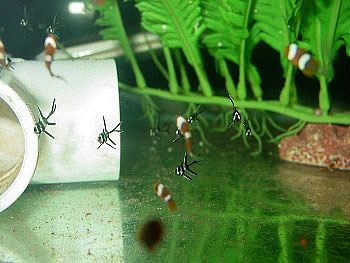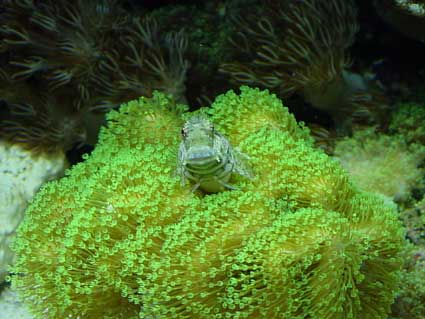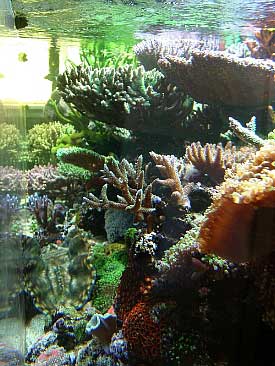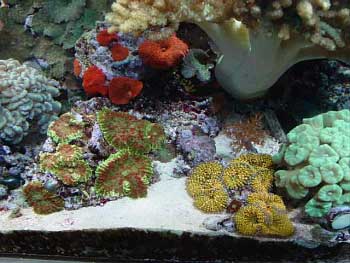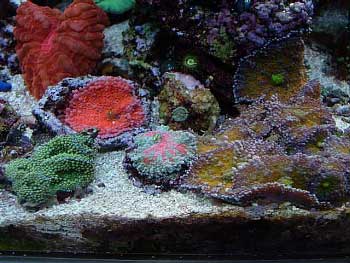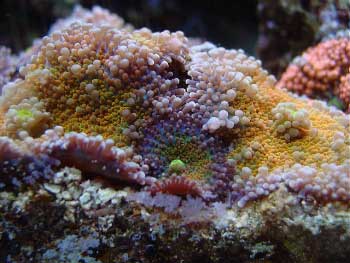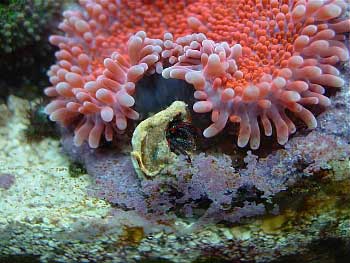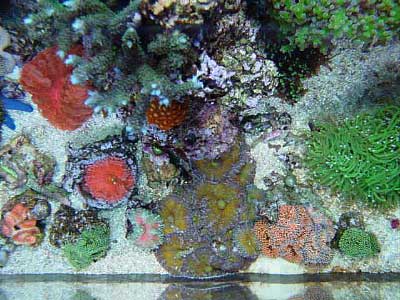Cris Capp's (cris) Reef Aquarium
Introduction:
"My tank a tank of the month?"
My wife was hearing that for a couple of days after I received
the e-mail from Skipper informing me that my tank had been
selected. I know that I've been admiring the previous tanks
of the month for quite some time, and consider it quite
an honor to be featured. Every time my parents come to visit,
they always tell my wife how sorry they are for installing
this "fish bug" into my brain at such an early
age. I guess it is true that the "fish bug" has
a firm grasp on my imagination. After a full day of work,
I love to come home to my family and then spend time tinkering
in the fish room. I think I've owned every size tank that
has ever been made, up to my current 300 gallon reef. While
most of them were freshwater tanks, that is how I learned
the ropes of keeping things alive and growing, which has
always been my goal.
My current main tank is the progression
of my success at keeping animals happy and the ever-growing
need for more room. Once again, the corals are growing out
of the tank, but my desire for a larger tank has waned with
the recent addition of a daughter to our family. Largely
due to hobbyists that share information on websites such
as Reef Central, I have learned a lot about this hobby and
love the advances that have been made in the last ten years.
I'm sure that numerous corals and fish have been saved through
the knowledge shared in these forums.
My current tank is the biggest that I
could fit through the basement window, or should I say the
hole remaining after we took the window out! A local company
that has since gone out of business custom built the tank.
The specifications on the setup are as follows:
|
Aquarium
Profile:
|
•
|
300
gallon acrylic tank |
|
•
|
120
gallon DIY acrylic sump |
|
•
|
Two
Little Giant 3MDQ-SC return pumps |
|
•
|
Three
Top® 60L per hour pumps & one Maxijet
600 |
|
•
|
Red
Sea Wavemaster Pro wavemaker |
|
•
|
Mostly
Fiji rock and CaribSea sand |
|
When I bought the 300 gallon tank, I
had a 120 gallon reef, so moving everything downstairs was
very easy. Most of the big colonies were in the 120 gallon
which was setup and running for three years prior to the
upgrade. The 300 gallon tank has been up and running for
two years now. The stand I built myself, and if needed,
I know I could park my car on top of it.
Circulation:
I have two Little Giant pumps, each on
its own circuit breaker. My thought was that if one of the
main pumps stopped working, then the other would hold down
the fort until I could replace or repair the broken one.
Being on separate breakers was the other reason for two.
I've had breakers trip while I was at work and wanted to
play it safe by having a backup.
Lighting & Other Equipment:
|
Lighting:
|
•
|
3
- 400 watt 20K Radiums with PFO hqi ballasts |
|
•
|
4
- 96 watt actinic power compacts |
|
•
|
2
- 160 watt URI actinics |
Photoperiod:
Actinics start coming on at 9am and stage off at 9pm.
Halides turn on at 10am and turn off at 8pm.
|
I've always been a fan of 20K metal halide
Radium bulbs and the only drawback is changing them out
at seven months. I have tried extending their effective
lifetime on several occasions and could really see a difference
in the color of the corals. I guess that is the price I
have to pay for the colors I want from my corals. I have
no problem with growth rates using 20K and recommend them
to people all the time.
|
Other
Equipment:
|
· EuroReef CS6-3
protein skimmer
|
|
· Vario dosing
pump for Kalkwasser supplementation
|
|
· Modified Lifereef
calcium reactor, 24" tall with Mag7 pump
|
|
· Milwaukee pH
monitor
|
|
· Pinpoint ORP
monitor
|
|
· Rainbow Lifeguard
thermometer
|
|
· Kent Hi-S 35
gpd reverse osmosis unit w/DI added
|
|
Maintenance:
|
Water
Parameters:
|
·
Calcium: ~420ppm
|
|
·
Alkalinity: 11-12 dKH
|
|
·
Specific Gravity: ~1.024
|
|
·
Temperature: 75 - 80°F
|
|
·
pH: ~8.0 - 8.2
|
|
·
ORP: ~450, but fluctuates
|
|
·
Iodine: .04ppm
|
|
My maintenance schedule is an easy one.
I make 5 gallons of kalkwasser per day for my top off water.
The only other chore that I routinely perform, besides scraping
algae off the glass every fourth day, is cleaning the skimmer.
The EuroReef skimmer works great but needs a little tweaking
to keep running at the best efficiency. I use a small drill
bit to clean the airline port that leads to the needle wheel
assembly, which tends to get clogged with salt buildup.
Also, I let the airline suck up a little freshwater to clean
the line from salt. The water is tested weekly and any necessary
supplements are added accordingly (rarely). Algal buildup
in the grooves of the overflow is removed every month. I
had my A. yongei grow to the surface and as the water
level grew because of the clogged overflow grooves, it just
kept growing. When I finally cleaned them out it dropped
the water level a ¼" and every branch was sticking
out of the water! Of course, algae seized the opportunity
and colonized the new atoll. I am a firm believer in the
corals being the "canary in the coal mine." I
monitor them closely and when they tell me that something
is wrong, I start my investigation.
Feeding:
Heavy! I remember the days that it was
recommended to feed every other day… until I tried
it myself and starved! I feed the fish a mixture of OSI
Spirulina and Marine flakes and Hikari Mysis shrimp
twice a day and the phyto mixture at night after the lights
go out. The corals and critters get ESV phytoplankton, Cyclop-eeze®,
and Golden Pearls (500-800 microns). I'm still not sure
what the best secret formula is, but this method is easy
and supplies a lot of different sizes of plankton in one
shot. Occasionally, I will feed the Ricordea mushrooms,
and anything that will grab it, some raw, diced table shrimp
soaked in Selcon™.
Inhabitants:
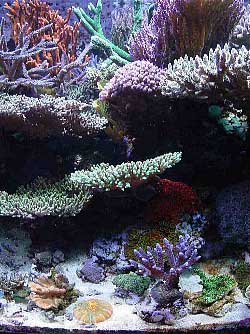 |
My livestock has been collected over
the last six years through various trades with other hobbyists,
numerous trips to the local fish store, and a little luck.
More than half of my colonies are grown out fragments, mainly
due to a limited budget over the years. I now feel more
confident in keeping corals alive and healthy, so occasionally
I will buy a wild colony. I keep 16 fish in the tank and
really feel they are secondary to the corals. I made the
mistake of originally starting with a lot of snails and
hermits but will try and only add snails from now on. Three
cleaner shrimp, one cucumber, one blue and one purple Linckia
starfish. I have Bangaii Cardinals and know of fourth generation
babies out there. I tried my hand at breeding my clownfish;
it was a great learning experience with rotifer cultures
but lost focus after I thought I was out of the danger zone
and lost all my clowns overnight due to poor water quality.
I will try again to raise them after I learn a little more.
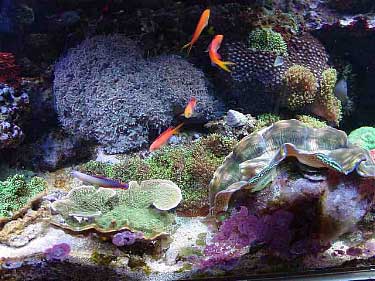 |
|
Fish:
|
|
1-
Royal Gramma
|
2-
Bangaii cardinals (breeding pair)
|
|
1- Mandarin Goby
|
1-
Sixline Wrasse
|
|
2-
False Perculas (breeding pair)
|
1-
Flame Angel
|
|
1-
Coral Beauty Angel
|
1-
Powder Blue Tang
|
|
1-
Scopas Tang
|
1-
Purple Tang
|
|
1-
Blue Tang
|
1-
Lawnmower Blenny
|
|
1-
Purple Firefish
|
4-
Dispar Anthias
|
|
1-
Flame Hawkfish
|
|
Invertebrates:
|
|
1-
Blue Linckia starfish
|
1-
Purple Linckia starfish
|
|
3- Cleaner shrimp
|
1-
Sally lightfoot crab
|
|
2-
Emerald crabs
|
1-
Common sea cucumber
|
|
~50
assorted hermit crabs
|
~50
Astraea and Cerithium snails
|
The corals are too numerous to list,
plus in all honesty, I don't know half of their scientific
names. I know that I need to buy Dr. Veron's Corals of
the World book series so I can identify and actually
sound like I know what I'm looking at. I have always loved
the look of a mixed reef and know that I am flirting with
disaster, but I keep a close eye on the skirmishes and water
quality in an effort to stop a problem before it starts.
The fragment grow-out tank.
Acknowledgements:
I would like to say thanks to the people
at Marine Depot. They are my on-line choice for equipment
and have been great from the first day I ordered. Additionally,
I'd like to that all the local fish stores in the area for
the hundreds of times they let me loiter in their store.
My thanks also go out to The
Rocky Mountain Reef Club which is growing and getting
stronger by the month. It is great to have a local resource
for questions and problems. I also call it a reef-geek support
group.
Concluding Remarks:
I hope you enjoyed my reef and I am always
up for trading for corals that I don't have already. What
a great hobby we all have! I would hate to lose part of
it through our own greed and stupidity. Make it a point
to support the local fish stores and suppliers who are doing
the right thing by taking the precautions to keep our resources
alive for the years to come by offering aquacultured livestock.
Feel free to comment
or ask questions about my tank in the forum
for the online magazine.
|



